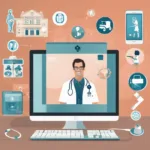24 January 2024
How Telemedicine is Transforming the Way We Access Medical Care
In recent years, telemedicine has emerged as a game-changer in the healthcare industry, revolutionizing the way medical care is delivered. With the advancement of technology and the increasing demand for convenient and accessible healthcare, telemedicine has gained significant traction. This article explores the various aspects of telemedicine and its impact on patients, healthcare providers, and the overall healthcare system.
1: Breaking Down Barriers to Access
Telemedicine has effectively broken down geographical barriers, allowing patients to access quality healthcare regardless of their location. In rural areas, where access to specialized medical care is limited, telemedicine has proven to be a lifeline. Patients can now connect with healthcare professionals remotely, eliminating the need for long-distance travel and reducing the burden on already strained healthcare facilities.
2: Enhancing Efficiency and Convenience
One of the key advantages of telemedicine is the convenience it offers to both patients and healthcare providers. Through virtual consultations, patients can seek medical advice from the comfort of their own homes, saving time and money. Healthcare providers, on the other hand, can efficiently manage their patient load by conducting virtual visits, reducing wait times, and streamlining their practice.
3: Improving Access to Specialists
Telemedicine has significantly improved access to specialized care, particularly for patients in underserved areas. Through teleconsultations, patients can connect with specialists who may be located in different cities or even countries. This has not only reduced the burden on tertiary care centers but has also allowed for timely diagnosis and treatment, ultimately improving patient outcomes.
4: Remote Monitoring and Chronic Disease Management
Telemedicine has also paved the way for remote monitoring and management of chronic diseases. With the help of wearable devices and remote monitoring tools, healthcare providers can track patients’ vital signs, medication adherence, and overall health status. This real-time data enables early intervention, preventing complications and reducing hospital readmissions.
5: Challenges and Limitations
While telemedicine offers numerous benefits, there are certain challenges and limitations that need to be addressed. Issues such as patient privacy and data security, reimbursement policies, and the digital divide need careful consideration to ensure equitable access to telemedicine services. Additionally, the human touch and physical examination cannot be completely replaced by virtual consultations, making it crucial to strike a balance between telemedicine and in-person care.
Conclusion:
Telemedicine has emerged as a powerful tool in healthcare delivery, transforming the way medical care is accessed and delivered. By breaking down barriers to access, enhancing efficiency, and improving specialized care, telemedicine has the potential to revolutionize the healthcare landscape. However, it is important to address the challenges and limitations to ensure that telemedicine is integrated seamlessly into the existing healthcare system, providing equitable and high-quality care to all. As technology continues to advance, telemedicine will undoubtedly play a pivotal role in shaping the future of healthcare.



